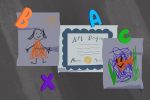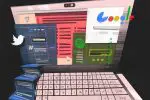Into the room they stride, exuding confidence, anxiety and a touch of relief — a combination of feelings familiar to test-takers everywhere. They spent months preparing, studied with private tutors and labored over half a dozen test-prep books. Now these young scholars must demonstrate their knowledge on the exam’s pages. Except there are no pages. There are no pencils. There are no scantron sheets. Instead, sitting on each desk is a tablet that contains the key to law school — the online LSAT.
The Law School Admissions Council (LSAC) unveiled the new format for the Law School Admissions Test (LSAT) on Oct. 3, 2018 and implemented a beta version at select test centers in June 2018, but many students still had apprehensions for September’s complete transition.
Kaplan Test Prep reports that most of their students wanted to be assigned the paper and pencil LSAT, rather than the online LSAT, during the beta period. Although Kaplan claims these preferences stem from a desire for familiarity rather than any true misgivings about the online LSAT, practice tests for the new format were not widely available before the beta period, leaving students understandably concerned.
“[LSAC] only provides three practice tests on the LSAC website that have the same format as the actual test,” explains Julia Nasiek, a classical studies and philosophy major at Seton Hall University.
Nasiek took a traditional LSAT in June and was among those assigned the beta online LSAT in July. Study habits that prepared her for the June test were inadequate for July, resulting in a score that less so reflected her intellectual capabilities, and more so an unfamiliar test format.
LSAC attempted to mitigate similar student anxieties by allowing score cancellation for those who took the online LSAT during the beta period. Students preparing for October’s LSAT, however, will not be able to wash the slate with such ease.
Transitioning to an online format is a deliberate decision LSAC made in response to a changing academic environment. Students today primarily receive information from online sources, often via mobile devices. They type notes on their laptops and keep flash drives of classwork. Podcasts replace lectures and university degrees are earned online without ever stepping foot on campus.
“LSAC research indicates that most LSAT test-takers are regular users of mobile devices and are familiar with reading and interacting with these devices,” reports the Princeton Review. “So [LSAC] made the test interface to function similarly to mobile apps.” The online LSAT is administered on Microsoft Surface Go tablets, complete with color blindness accommodations, a stylus, five-minute warnings, highlighting, control of text size and the ability to flag skipped questions.
Responses to the online LSAT were generally positive, but not exceptional: 17% of Kaplan students rated the test as “very good,” another 17% as “poor” or “very poor” and the other 66% found it merely “good” or “fair.” Surveys show that 99.3% of students assigned the digital format during the beta period successfully completed the exam, but LSAC says it will not be satisfied until 100% of testers are comfortable with online platform.
We're counting down the days to the launch of the Digital LSAT. In our latest Law:Fully blog, we talk about the planning that went into the transformation and answer the two hottest questions: How does it work, and what if something goes wrong? Find out: https://t.co/6MV078p5u8 pic.twitter.com/nMKkbjOlIz
— Law School Admission Council (@LSAC_Official) June 11, 2019
“By looking at aggregated data on how tens of thousands of students interacted with the digital test,” reads the LSAC website, “we expect to learn a great deal about the functioning of each LSAT question and each answer choice at a level of detail we have never seen from a paper test.”
Obviously, there are still kinks with the online LSAT. Most students complain of an oversensitive stylus that incorrectly highlights words, was not equipped to take notes on the exam itself and was time consuming to use. “While taking the test [students are given] highlight and underline tools, but they are not very responsive,” says Jed Rice, a classical studies major at Seton Hall University. “And you cannot even make notes on the tablet. Instead you are given a 10-page LSAT scratch paper book.”
Scratch paper is given to accommodate students who are dissatisfied with the feel of a stylus, but as Rice later notes, being unable to write directly on the test inhibits quick, precise performance, especially on the logic section.
This seemingly mundane annoyance is actually a serious issue as student attention instantly shifts from the LSAT material to the process of highlighting — an action that should be a simple motor skill. Precious time is wasted correcting technological faults rather than answering questions.
Another major issue is the onboarding and set-up process. Both Nasiek’s and Rice’s tests delayed starting by an hour due to technical difficulties. A center in Florida rescheduled the test altogether for similar issues, which caused further problems regarding test security.
Personal preference also heavily impacts a student’s test experience and performance. Caleb Yeager, who took the LSAT in Pennsylvania, told LSAC he read quicker on the tablet, as did Rice. Nasiek, however, wished more time was allotted to the reading comprehension section given many students experience difficulties in processing and retaining electronic print material.
The online LSAT also allows students to adjust font size, which is a major improvement for those with visual impairments. But during the beta period, time was not allotted to adjust font prior the test start, meaning students fidgeted with text size after the timed session was underway.
We are constantly working to evaluate and update the LSAT for the future. Shorter test? Fewer questions? Different ways to assess important skills? Some of the things we’re exploring might surprise you. https://t.co/ujAwspFITI pic.twitter.com/fNt3UEMW5b
— Law School Admission Council (@LSAC_Official) October 4, 2019
Although question format and content remain the same, the online LSAT is shorter than the paper test, as the written section is now administered separately. Students can complete the writing section via an online platform up to a year after their multiple-choice test date. Students will also receive test scores more quickly as scantron answer sheets are no longer used. Those who took the September test can expect score reports by Oct. 14.
Despite preliminary glitches and misgivings, the switch to a digital format is likely necessary as academia begins to lean more heavily on technology in the classroom. Nasiek also notes the environmental benefits of going paperless by using a tablet.
If initial growing pains are addressed by the Oct. 28 LSAT, public opinion might sway more in favor of the new online format. But until then, Rice sums up what seems to be the current consensus among test takers and LSAC officials alike: “The electronic LSAT was a great idea, but poor execution.”
















